#ancient sponge fossil
Explore tagged Tumblr posts
Photo

Rare Fossil Sponge Porosphaera globularis – Upper Chalk Cretaceous, Kent UK – Genuine with COA
Discover a rare and fascinating piece of Earth’s ancient marine history with this authentic fossil sponge – Porosphaera globularis, dating from the Upper Chalk of the Late Cretaceous period. This unique specimen was sourced from Kent, UK, a region renowned for its rich fossil-bearing chalk formations.
Porosphaera globularis is a globular-shaped sponge species commonly found in chalk deposits and known for its distinctive porous structure. These sponges lived approximately 70–90 million years ago when much of Europe was submerged under a warm, shallow sea. Their preservation in chalk provides an incredible window into ancient marine ecosystems.
Item Details:
Species: Porosphaera globularis
Age: Upper Chalk, Late Cretaceous (~70–90 million years old)
Location Found: Kent, United Kingdom
Condition: 100% genuine fossil specimen with clear structural features
Scale: Scale cube in photo is 1cm – please refer to images for full sizing details
Photography: The specimen shown is the exact item you will receive
Packaging: Securely packaged to ensure safe delivery
This fossil is ideal for collectors, educators, or anyone with a passion for natural history. It comes with a Certificate of Authenticity, affirming its genuine origin and geological significance.
All of our fossils are carefully selected for quality and scientific interest. Don’t miss the opportunity to own a real piece of prehistoric life!
#fossil sponge#Porosphaera globularis#Cretaceous fossil#Upper Chalk fossil#Kent fossil#UK fossil sponge#ancient sponge fossil#genuine fossil#fossil with certificate#educational fossil#natural history#fossil collection#sponge fossil#chalk fossils#rare fossil specimen
0 notes
Text
Round 2 - Arthropoda - Pycnogonida




(Sources - 1, 2, 3, 4)
Pycnogonida is a class containing one order: Pantopoda, which means “all feet.” A fitting name for creatures that seem to be made entirely of legs. Commonly called “Sea Spiders”, they are not spiders, nor are they arachnids, but are actually a sister group to all other living arthropods.
Pycnogonids live in most oceans. Most are tiny, living in relatively shallow water, though some can grow to be quite large in antarctic and deep waters. Some pycnogonids are so small that each of their muscles consists of a single cell. They have a proboscis which they use to suck nutrients from soft bodied invertebrates such as cnidarians, sponges, polychaetes, and bryozoans. They can also insert their proboscis into anemones, though this rarely kills the anemone. The pycnogonid digestive tract extends into their legs. They are segmented, with the first body segment (the cephalon) consisting of the proboscis, the ocular tubercle with up to 4 simple eyes, a pair of chelifores, a pair of palps, a pair of ovigers, and the first pair of walking legs. Ovigers are used for cleaning themselves, courtship, and caring for eggs and young. Nymphonidae is the only family where both the chelifores and palps (sensory organs) remain functional. In others, these limbs are reduced or absent, instead relying on a well-developed and flexible proboscis equipped with sensory bristles. Pycnogonids are usually comprised of eight walking legs, but the family Pycnogonidae includes species with ten, and the families Colossendeidae and Nymphonidae include species with up to twelve legs! While most species have up to 4 eyes, some deep-sea species lack them entirely. Pycnogonids do not have a traditional respiratory system, instead absorbing oxygen through their legs and diffusing it throughout their body via hemolymph. Their small, long, thin hearts beat vigorously at 90 to 180 beats per minute, creating substantial blood pressure. Their nervous system consists of a brain which is connected to two ventral nerve cords, which in turn connect to specific nerves. Like other arthropods, they molt their exoskeleton as they grow.
Pycnogonid reproduction involves external fertilization after a brief courtship involving the male stroking the larger female with his ovigers and receiving the eggs if she is responsive. The couple must adjust their position until the genital pores on their legs are perfectly aligned. Only males will care for eggs and young, and in some species only the males will have ovigers while the females do not, as these limbs are used mainly for carrying and cleaning the eggs. Larvae consist only of a head with chelifores, palps and ovigers. Extra segments and legs emerge as it grows into an adult. There are at least four different types of larvae. The typical protonymphon larva is most common, is free living and gradually turns into an adult. The encysted larva spends its larval days as a parasite, finding a host in a colony of polyps, burrowing into one, turning into a cyst, and not leaving the host until it has become a juvenile. The atypical protonymphon larva lives on or within a temporary host such as a clam or polychaete worm, does not encyst or otherwise harm their host, and leaves them as an adult. Lastly, the attaching larva hatches as an embryo and immediately clings to the legs of its father, only leaving once it has two or three pairs of its own walking legs.
The pycnogonid’s cerebral appendages are unique, not found anywhere else among arthropods, except in fossils like Anomalocaris. This could mean that pycnogonids are the last surviving (highly modified) members of an ancient stem group of arthropods that lived in Cambrian oceans.

Propaganda under the cut:
They are good dads. All of them. Perfect fathers made of legs.
Their leg arrangement allows them to move forward, backward, and sideways without turning their body.
The genus Colossendeis (image 2) includes the largest pycnogonids, which live in the ocean depths. Some of them are even bioluminescent! The largest is Colossendeis colossea which can reach a leg span of 70 cm (28 in). However, their body length, including proboscis and abdomen, only reaches 7 cm (2.8 in).
About 20% of the known species of pycnogonids live in Antarctica. The cold never bothered them anyway.
One known species, Ascorhynchus corderoi, is hermaphroditic, having both ovaries and testes.
178 notes
·
View notes
Text

"Devil's Corkscrews," Niobrara River, Nebraska, USA,
In the late 1800s, a remarkable fossil discovery in what is now northwestern Nebraska captured the imagination of scientists and sparked decades of research.
At the Agate Springs quarries, paleontologists unearthed something entirely unexpected—giant, spiral-shaped fossil structures buried deep underground. These mysterious formations, often several feet tall and coiled like ancient tree trunks, were unlike anything seen before. Their peculiar shape and massive size puzzled researchers for years. What could they be?
Initially dubbed “devil’s corkscrews,” these structures were thought to be the fossilized roots of ancient trees or even the remains of giant freshwater sponges. But as investigations continued, a more grounded explanation emerged.
Scientists eventually determined that these spirals were actually burrows—complex underground dens created by an extinct genus of land-dwelling beavers known as Palaeocastor.
The construction of spiral burrows required more effort from paleocastorines than digging straight inclined passages of the same length. Among the reasons that led burrowing beavers to this form is their territorial crowding: in conditions of large colonies, straight burrows should have often intersected.
According to another assumption, the unusual shape of the burrows was a response to the hot and dry climate of that era. From this point of view, its spiral design could have been a kind of air conditioning system for maintaining an optimal temperature and humidity regime inside the nesting chamber, which was especially important for the successful breeding of offspring.
Today, the “devil’s corkscrews” remain one of North America’s most fascinating and bizarre fossil discoveries—a testament to the strange and adaptive behavior of prehistoric life, preserved in stone beneath the Nebraska prairie.
Photo by B. Nicholls
#art#design#stairwell#stairway#architecture#spiral staircase#ramp#fossil#animals#burrow#underground#palaeocastor#miocene#devil#corkscrews#usa#prehistoric#nebraska#niobrara#agathe springs#tunnel#nest#shelter#nature#nature's engineers
38 notes
·
View notes
Note
MURMAIDER MURMAIDER MURMAIDER!!! 😂😂😂
Any ideas what the other members of Dethklok would be like as mers, if Nathan is a whale shark?
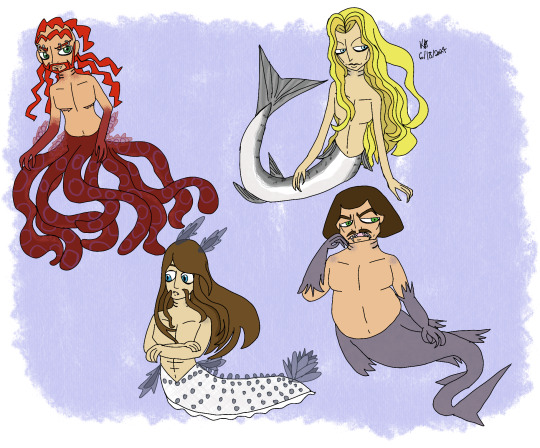
Underwater friends!
Just for your listening pleasure here’s all 3 murmaider songs too.
Pickles was the easiest because he is already associated with sea life, his ancient animal is the octopus! Now I specifically was inspired by the blue ring octopus, since it’s one of the most venomous cephalopods in the sea and Pickles is known for his excessive drinking and recreational drug usage. (I mean so is the rest of Dethklok, but him more so)
Now originally I was going to use the tiger shark for Murderface to link him back to his ancient animal, but I decided to go for a goblin shark instead. In canon Murderface is considered the ugliest member of Dethklok. (Not true imo). And the goblin shark isn’t too much of a looker either. However, a fact I linked them together with is that the goblin shark is sometimes called a “living fossil”. And Murderface is a history enthusiast, so maybe he’d be into paleontology too.
Ok, so Toki is associated with cute animals. And it would have been a copout to me if I used a catfish. So I went the opposite route and linked him back with his ancient animal, the rabbit. And what’s a cute sea creature that looks like a bunny, a sea slug! It gave me the excuse to create a merslug. The specific type is scientifically called “Jorunna parva” and it’s known to eat poisonus sea sponges. If this picture were more accurate in terms of height, Toki would be a centimeter tall.
Finally we’re onto Skwisgaar. He was the hardest one to pin down, his association in terms of land animals are very much all over the place. So no luck there. I decided to use his most common traits to really hone in on a species. To add on to it, I searched up native species from his homeland of Sweden. I ended up with the Atlantic salmon. Skwisgaar is one of the fastest guitarists alive and has notoriously high fertility rate. And salmon are super fast swimmers and are known for breeding thousands of eggs, with whole farms dedicated on harvesting their roe.
I suppose if this we’re a full blown AU it’d be have a “there is a benefit to being a marine biologist” vibe. I’m not a marine biologist by the way, I just like researching fish sometimes. Anyway, I hope you like this piece! :3
#requesummer 4#my art#metalocalypse#dethklok#pickles the drummer#william murderface#toki wartooth#skwisgaar skwigelf#ask#request#mermen#merman
38 notes
·
View notes
Text

Mountains Made of Fossils
Rocks that formed beneath the waves of an ancient sea now make up some of the loftiest peaks in Texas. Rising above the Chihuahuan Desert in West Texas and southern New Mexico, the Guadalupe Mountains are part of one of the best-preserved fossil reefs from the Permian Period. The cemented accumulation of plant and animal material constitutes a revealing record of aquatic life before a mass extinction event at the end of the Permian.
The Texas portion of this range is part of Guadalupe Mountains National Park, established in 1972. The park is outlined in the image above, acquired with the OLI-2 (Operational Land Imager-2) on Landsat 9 on July 7, 2024. To the northeast, where the exposed fossil reef stretches into New Mexico, sulfuric acid has eaten away at the rock to form the massive caves within Carlsbad Caverns National Park.
In the Permian Period, which lasted from about 300 to 250 million years ago, this area was situated on the edge of a shallow inland sea on the supercontinent Pangea. The Capitan Reef formed in this coastal environment and was composed mostly of sponges and algae. Other fossilized marine life found here includes ammonites, bivalves, brachiopods, crinoids, snails, and trilobites.
Global sea levels fell toward the end of the Permian, and Capitan Reef became buried under thousands of feet of newer sediments. It remained preserved this way for more than 200 million years. Within the past 20 million years, tectonic forces moved the rocks skyward. Softer rock layers then eroded away and left the more resistant reef exposed. Along with the Guadalupe Mountains, uplifted portions of Capitan Reef also comprise the Apache and Glass Mountains in Texas.

El Capitan (above) is a striking display of the fossilized reef and one of the more iconic vistas in Guadalupe Mountains National Park. Its sheer, 1,000-foot-high limestone cliff tops out at 8,085 feet (2,464 meters), making it one of the 10 highest peaks in the state. Most of Texas’s highest mountains—including the very tallest, Guadalupe Peak at 8,751 feet (2,667 meters) above sea level—are also in the park.
People seeking a more immersive encounter with the deep past may find it in the park’s northeast corner. The Permian Reef Trail brings hikers close to fossil beds and serves as a tour through the former marine environment, from seafloor to reef, as it ascends the north side of McKittrick Canyon. The canyon itself is sometimes referred to as the “most beautiful spot in Texas,” and a trail winding through it (below) is popular for viewing autumn colors.

The western side of the park offers an entirely different sort of landscape. There, piles of bright-white gypsum grains form dunes up to 60 feet (18 meters) tall. The dunes are located in a low-lying basin with no outlet; water that intermittently flows there evaporates to leave behind these mineral deposits. Today, with significant rain, an inches-deep lake may form temporarily in the basin. Otherwise, the deposits are left to be shifted about by prevailing westerly winds.
Editor’s Note: Explore satellite imagery of other national parks for National Park Week.
NASA Earth Observatory image by Wanmei Liang, using Landsat data from the U.S. Geological Survey. Photo of El Capitan courtesy of NPS. Photo of McKittrick Canyon courtesy of Matthew Lee High. Story by Lindsey Doermann.
7 notes
·
View notes
Text

the redjam sea or sea of sweetness, is full of toxic algae and metals that sting your nose and mouth with and obscene sweetness, animals pour from the fields in great migrations to feast and die at its shores, leaving sticky trails of red strewn across the shores, most commonly large reddish house centipedes and rust covered snails that crawl from the crevices of the northern shore, the numerous bugs are harvested as food or for their shells the water when cooked down can be used as a tar and sealant and most famously a red paint, some people also eat it as a delicacy risking their health int he process
the sea of milk is a place of still opaque white fluid, primordial ancient things linger there, softly padding in the waves where most seas have a vermin clinging to the shores these ones lurk in the deep unseen, things very old live there long ago the goddess of the earwigs beckoned them from the pale waters and set them to fly to the moon and return only when they became wise
there is not a whole lot of industry around this sea the animals and crafty and things get eaten and gnawed upon when the earwigs emerge at night, there however are more farming settlements farther into the golden lands where the endless grain sates the appetite of the earwigs before they can reach
there are many monasteries and such things built in the seclusion they have found it difficult to keep records without using materials that the earwigs detest the red pigment from the sea of sweetness works well
the cadaverine seas waters are chilled and smell of rot there are numerous mass dyings and blobster like things washed upon the shores, the water is somewhat corrosive and one must were a waxed suit to safely wade, the waters are not filled with much except barnacles, molluscs, brachiopods,and echnoderms fished commonly in row boats with thick coating to prevent the encrusting of life on them, the corpses of the the waxy beasts are harvested and distilled into medicines healing salves and sedatives that have the side effect of giving dreams of one being trapped in mud at the bottom of the sea, in ancient times people built great sarcophagi to store the bodies of the giant waxy whale fish things, and referred them as saints, the fluid of the tombs is a legendary medicine
the gloaming sea is covered in churning pewter waves, cast in never ending twilight there is a great black engine built on the cliffs chains as light as spider silk are cast into the air like a net and as the sun sets apparitions sparks of angels burn into being for an instant before becoming entangled the great engine starts up and reels them in as night falls not sure what they do with them make lightbulbs idk the engine is powered both my the lapping waves agains the great steel wheels but also a material unique to this are called verminstone, its quarried nearby and shipped on rails, it resembles ancient sea fossils, byrozoans, coral, diatoms, sponges porus and once alive, it works when you dont look a rattling in a dark box so they are poured into the engine like coal great rattling and cacophony, worms that creeped so long ago led ghostly in great procession turning the heavy gears
10 notes
·
View notes
Text
List of all SDV and SDV:E (Stardew Valley: Expanded) Giftable Items
Horseradish
Daffodil
Leek
Dandelion
Parsnip
Cave Carrot
Coconut
Cactus
Banana
Sap
Large Egg
Egg
Milk
Large Milk
Green Bean
Cauliflower
Potato
Garlic
Kale
Rhubarb
Melon
Tomato
Morsel
Blueberry
Fiddlehead Fern
Hot Pepper
Wheat
Radish
Red Cabbage
Starfruit
Corn
Rice
Eggplant
Artichoke
Pumpkin
Bokchoy
Yam
Chanterelle
Cranberry
Holly
Beets
Ostrich Egg
Salmonberry
Amouranth
Pale Ale
Hops
Void Egg
Mayonnaise
Duck Mayonnaise
Void Mayonnaise
Clay
Copper Bar
Silver Bar
Gold Bar
Iridium Bar
Refined Quartz
Honey
Pickles
Jam
Beer
Wine
Juice
Clam
Poppy
Copper Ore
Silver Ore
Coal
Gold Ore
Iridium Ore
Wood
Stone
Nautilus Shell
Coral
Summer Shell
Spice Berry
Sea Urchin
Grape
Spring Onion
Strawberry
Sweet Pea
Common Mushroom
Wild Plum
Hazelnut
Blackberry
Winter Root
Crystal Fruit
Snow Yam
Sweet Gem Berry
Crocus
Red Mushroom
Sunflower
Purple Mushroom
Cheese
Goat Cheese
Cloth
Truffle
Truffle Oil
Coffee Bean
Goat Milk
Large Goat Milk
Wool
Duck Egg
Duck Feather
Caviar
Lucky Rabbit’s Foot
Aged Roe
Ancient Fruit
Mead
Tulip
Summer Spangle
Fairy Rose
Blue Jazz
Apple
Green Tea
Apricot
Orange
Peach
Pomegranate
Cherry
Bug Meat
Hardwood
Maple Syrup
Oak Resin
Pine Tar
Slime
Bat Wing
Rusty Blade
Swirl Stone
Solar Essence
Void Essence
Void Pebble
Void Shard
Void Soul
Fiber
Battery
Dinosaur Mayonnaise
Roe
Squid Ink
Tea Leaves
Ginger
Taro Root
Pineapple
Mango
Cinder Shard
Magma Cap
Bone Fragment
Radioactive Ore
Radioactive Bar
Ancient Fiber
Bearberry
Conch
Dried Sand Dollar
Ferngill Primrose
Golden Ocean Flower
Goldenrod
Green Mushroom
Four-Leaf Clover
Monster Fruit
Monster Mushroom
Mushroom Colony
Poison Mushroom
Red Baneberry
Salal Berry
Slime Berry
Rafflesia
Sports Drink
Stamina Capsule
Thistle
Void Root
Winter Star Ross
Dewdrop Berry
Aged Blue Moon Wine
Blue Moon Wine
Aegis Elixir
Armor Elixir
Barbarian Elixir
Gravity Elixir
Haste Exilir
Hero Elixir
Lightning Elixir
Pufferfish
Anchovy
Tuna
Sardine
Bream
Largemouth Bass
Smallmouth Bass
Rainbow Trout
Salmon
Walleye
Perch
Carp
Catfish
Pike
Sunfish
Red Snapper
Herring
Eel
Octopus
Red Mullet
Squid
Seaweed
Green Algae
Seacucumber
Super Seacucumber
Ghost Carp
White Algae
Stone Fish
Crimsonfish
Angler
Icepip
Lava Eel
Legend
Sandfish
Scorpion Carp
Flounder
Midnight Carp
Mutant Carp
Sturgeon
Tiger Trout
Bullhead
Tilapia
Chub
Dorado
Albacore
Shad
Lingcod
Halibut
Lobster
Crayfish
Crab
Cockle
Mussel
Shrimp
Snail
Periwinkle
Oyster
Woodskip
Glacierfish
Void Salmon
Slimejack
Midnight Squid
Spookfish
Blobfish
Stingray
Lionfish
Blue Discus
Baby Lunaloo
Bonefish
Bull Trout
Butterfish
Clownfish
Daggerfish
Dulse Seaweed
Frog
Gemfish
Goldenfish
Grass Carp
King Salmon
Kittyfish
Lunaloo
Meteor Carp
Minnow
Puppyfish
Radioactive Bass
Razor Trout
Seahorse
Sea Sponge
Shiny Lunaloo
Snatcher Worm
Starfish
Torpedo Trout
Undeadfish
Void Eel
Water Grub
Dwarf Scroll 1
Dwarf Scroll 2
Dwarf Scroll 3
Dwarf Scroll 4
Chipped Amphora
Arrowhead
Ancient Doll
Elvish Jewelry
Chewing Stick
Ornamental Fan
Dinosaur Egg
Rare Disc
Ancient Sword
Rusty Spoon
Rusty Spur
Rusty Cog
Chicken Statue
Ancient Seed
Prehistoric Tool
Dried Starfish
Anchor
Glass Shards
Bone Flute
Prehistoric Handaxe
Dwarvish Helm
Dwarf Gadget
Ancient Drum
Golden Mask
Golden Relic
Strange Doll
Strange Doll
Prehistoric Scapula
Prehistoric Tibia
Prehistoric Skull
Skeletal Hand
Prehistoric Rib
Prehistoric Vertebrae
Skeletal Tail
Nautilus Shell
Amphibian Fossil
Palm Fossil
Trilobite
Emerald
Aquamarine
Ruby
Amethyst
Topaz
Jade
Diamond
Prismatic Shard
Quartz
Fire Quartz
Frozen Tear
Earth Crystal
Alamite
Bixite
Baryite
Aerinite
Calcite
Dolomite
Esperite
Fluorapatite
Geminite
Helvite
Jamborite
Jagoite
Kyanite
Lunarite
Malachite
Nepunite
Lemon Stone
Nekoite
Orpiment
Petrified Slime
Thunder Egg
Pyrite
Ocean Stone
Ghost Crystal
Tiger’s Eye
Jasper
Opal
Fire Opal
Celestine
Marble
Sandstone
Granite
Basalt
Limestone
Soapstone
Hematite
Mudstone
Obsidian
Slate
Fairy Stone
Star Shards
Fried Egg
Omelet
Salad
Cheese Cauliflower
Baked Fish
Parsnip Soup
Vegetable Medley
Complete Breakfast
Fried Calimari
Strange Bun
Lucky Lunch
Fried Mushrooms
Pizza
Bean Hotpot
Glazed Yams
Carp Surprise
Hashbrowns
Pancakes
Salmon Dinner
Fish Taco
Crispy Bass
Pepper Poppers
Bread
Tom Kha Soup
Trout Soup
Chocolate Cake
Pink Cake
Rhubarb Pie
Cookies
Spaghetti
Spicy Eel
Sashimi
Maki Roll
Tortilla
Red Plate
Eggplant Parmesan
Rice Pudding
Ice Cream
Bluberry Tart
Autumn’s Bounty
Pumpkin Soup
Super Meal
Cranberry Sauce
Stuffing
Farmer’s Lunch
Survival Burger
Dish’O’The Sea
Miner’s Treat
Roots Platter
Triple Shot Espresso
Seafoam Pudding
Algae Soup
Pale Broth
Plum Pudding
Artichoke Dip
Stir Fry
Roasted Hazelnuts
Pumpkin Pie
Radish Salad
Fruit Salad
Blackberry Cobbler
Cranberry Candy
Bruschetta
Coleslaw
Fiddlehead Risotto
Poppyseed Muffin
Chowder
Fish Stew
Escargot
Lobster Bisque
Maple Bar
Crab Cakes
Shrimp Cocktail
Ginger Ale
Banana Pudding
Mango Sticky Rice
Poi
Tropical Curry
Squid Ink Ravioli
Mushroom Berry Rice
Big Bark Burger
Flower Cookie
Frog Legs
Glazed Butterfish
Grampleton Orange Chicken
Mixed Berry Pie
Baked Berry Oatmeal
Void Delight
Void Salmon Sushi
#Mistakes have likely been made and I will not be fixing them so just reply to the post with any corrections#sdv#stardew#stardew valley#sdv:e#sdve#stardew expanded#stardew valley expanded#giftable items#sdv items#sdv gifts#sdv gifting#long post
7 notes
·
View notes
Text
Flint and the magic of history
For hundreds of thousands of years, our ancestors back to the stone age have been using flint (and obsidian) tools in areas where those rocks are abundant. The art of shaping flint has been lost to most for generations, but with the help of archaeology and extant ruins we can uncover some of the techniques they used. But what does that have to do with Witchcraft?
Lots!
First of all, it helps us connect to our ancient history and the spirits of our ancestors. Connecting to the practical work of our ancestors and ancient people is important for death and spirit work, even those whose language we would not understand at all today. Those people existed on the same land as us, and they can speak to us through these practices. We can feel a little bit of how they felt back when they lived their lives, how they might have shaped a tool they used to hunt and to carve wood to help build their homes. The very bricks used in the middle ages, even, were often knapped flint. Most especially ancient holy sites and churches.
Flint is a double-edged sword, used for hunting and building a home where you can be protected from the elements and the outside world. As such, it is an especially versatile rock in Witchcraft. It can protect you against the elements and it can carve new life through death, the hunting of prey that eas practiced from the time of our ancestors. It built the walls which are sacred to many Christians, medieval churches and monasteries were commonly made of flint. But its roots go much earlier than Christianity.
The rock itself is also extremely diverse! It is a type of quartz/chert that is rock hard, shattering in unique patterns when struck. It's razor sharp edges were used for cutting meat and as a scalpel, as well as arrow heads and small axes. It comes in many different colours, from red to orange, brown, grey-blue and almost black (though obsidian is black it is a similar but distinct stone). Encased in flint you can often find deposits of various minerals, including quartz, ancient sponges, fossils and iron to name a few.
I use each colour of flint slightly differently: red and orange flint for heart and connection to the earth and family, grey and blue flint for protection and stability. Hag stones are also commonly made of flint and they are excellent forms of protection. Flint pebbles and shards make an excellent addition to a grounding, protection or friendship spell bag, and can help bring you closer to the gods.
In my next post on flint I will talk more about the practice of flint knapping itself and how I use it in my practice.
#flint magic#the warlock speaks#crystal magic#ancestral work#neo pagan#ancient christianity#witchcraft#witchblr
11 notes
·
View notes
Text




This is an sample arrangement of various of my flint sponges found here from the local fossil searches. The aulaxinia are the prominent ones.
Have shown some here in the past, i do plan to do more in the future for the blog & audience.
Also to compare the difference in them, other genus finds or alike from shattered parts of them. Have plenty of traces like these seen and picked up now. Mostly grey, blue or dull tranculent in sun light.
I have an box now full with the little round plinthosella sponges, round, in half broken, some with an core or not. And a lot more.
Bit of unlucky to find an real Klapperstein here, with an lose ancient part as an core in the middle.
Near the chalkcoast Kreidefelsen or France are they often to find from native people or tourists.
Some of the bigger rocks can have an core, partial merged core or crystals build in them like an mini geode.
The ovale long broken parts or as an whole flint rock with their remicent wave pattern, aulaxinia sulcifera sponge will presented as an whole artikel of my finds coming soon.
They deserve an extra set of photos of the half, big and small ones.
Some broken open with inner strucktures or flint nodules forming around them can build tiny silicat crystals forming in the inner part or along the wave membrane lining. Like here.
Have plenty now of good in various size finds or broken parts of their ends. Like an stone cucumber, or well an prehistoric stone dildo.
Some imprints in flat stones from other specimen, five different in total found recently, and of course the round coral looking one like an dry fig the Astylospongia praemorsa.
The previous & upcoming spongi finds will featured as an reblog in the future.
#plinthosella#aulaxinia sulcifera#sponge fossil#flint fossil#fossils in germany#rocks#fossil collecting#fossils#geology
0 notes
Text
Oak frowned thoughtfully at the question. "I'm afraid I don't know offhand the answer to that, but it's certainly something we can look up. Orre in general has a low population of wild pokemon and until recent years didn't have any wild populations at all, if I remember correctly…"
As for Nata's other observation… "Yes, pokemon can be dangerous, especially if you encounter some of the more aggressive species or if they feel threatened. It's why we don't usually send trainers off without a partner of their own, after all. Or in some of the regions where humans only recently have settled, and the pokemon are not used to cohabiting. But for the most part they're fairly peaceful when left undisturbed. They're just like people, really."
The professor began pulling up new files, this time on Orre specifically. "Let's see… desert, mountain… Yes. So, I presume that by extinct in this case we mean ancient pokemon that no longer exist in the modern day, yes? Or at least, pokemon that no longer have living breeding populations in the wild that we are aware of and only exist through fossil revival technology. That would be much different than extant pokemon elsewhere that have gone in extinct in the sense they no longer have a wild population in Orre, but still exist in most other regions." He tapped a few keys, before a printer across the room began spitting out papers.
"I'll print us a list to look over, hm? Perhaps your mysterious pokemon may be on it." He was beginning to get a better idea of the boy now, and just why Lance had brought him. Fear aside, he certainly did seem to soak up knowledge like a sponge. While Oak suspected that Lance had perhaps pushed a little too hard a little too quickly, he was probably correct in that Nata had needed a safe environment to learn about pokemon.
Bringing him to the lab surrounded by pokemon, though. Honestly. Oak could have just as easily had this interaction with him in Viridian, or over a video call and email. Well, at least the pokemon were behaving today and staying out of the lab.
AND IT WAS AS THE PROFESSOR EXPLAINED HIMSELF, that Nata's inner curiosity began to come out of the woodwork. The growing shine in his eyes is that of a child who let their imagination run wild. Few youngsters were eager to listen. Fewer still retained what they'd learned unless it was something they were passionate about.

But to Nata, who next to nothing about the world beyond his little village and then some, all of this was fascinating. "Really?" The tone of his voice was the tone of someone truly astounded—for he had never known just how much the world had changed. He didn't realize that humans and pokemon had lived together for so long! No human being had set foot beyond his homeland in a thousand years—what had prompted them to fear such creatures?
Steadily, the boy goes from keeping a careful distance to practically peering right over the professor's shoulder, head canting slowly to one side as he examined pictures and files of peculiar ruins, big and small. The Ruins of Alph, the patron statues and murals of Celestic Town, the walls of a sunken castle within Unova's desert.
"Where I come from, we were always told to fear pokemon. That they're dangerous," He admits, almost sadly. "Though the morelull and bronzor in the tunnels never seemed to bother us. They kept to themselves, always."
The one that had attacked his village, on the other hand . . . Nata thinks as he takes the notebook in hand. He flips through it, scanning briefly, before he musters the bravery to ask a tentative question. " . . . What pokemon are extinct in the Orre region?"
. . . A pause. He fiddles with the pendant around his neck sheepishly, eventually giving it a squeeze with his palm. "It's the region where I'm from. Alma says the pokemon that attacked my village might be an extinct species."
19 notes
·
View notes
Photo

Rare Fossil Sponge Porosphaera globularis – Upper Chalk Cretaceous, Kent UK – Genuine with COA
Discover a rare and fascinating piece of Earth’s ancient marine history with this authentic fossil sponge – Porosphaera globularis, dating from the Upper Chalk of the Late Cretaceous period. This unique specimen was sourced from Kent, UK, a region renowned for its rich fossil-bearing chalk formations.
Porosphaera globularis is a globular-shaped sponge species commonly found in chalk deposits and known for its distinctive porous structure. These sponges lived approximately 70–90 million years ago when much of Europe was submerged under a warm, shallow sea. Their preservation in chalk provides an incredible window into ancient marine ecosystems.
Item Details:
Species: Porosphaera globularis
Age: Upper Chalk, Late Cretaceous (~70–90 million years old)
Location Found: Kent, United Kingdom
Condition: 100% genuine fossil specimen with clear structural features
Scale: Scale cube in photo is 1cm – please refer to images for full sizing details
Photography: The specimen shown is the exact item you will receive
Packaging: Securely packaged to ensure safe delivery
This fossil is ideal for collectors, educators, or anyone with a passion for natural history. It comes with a Certificate of Authenticity, affirming its genuine origin and geological significance.
All of our fossils are carefully selected for quality and scientific interest. Don’t miss the opportunity to own a real piece of prehistoric life!
#fossil sponge#Porosphaera globularis#Cretaceous fossil#Upper Chalk fossil#Kent fossil#UK fossil sponge#ancient sponge fossil#genuine fossil#fossil with certificate#educational fossil#natural history#fossil collection#sponge fossil#chalk fossils#rare fossil specimen
0 notes
Text
Round 3 - Chondrichthyes - Heterodontiformes




(Sources - 1, 2, 3, 4)
While several extinct genera of Heterodontiformes are known from the Jurassic, today only one genus, Heterodontus, the “Bullhead Sharks” remains. Ten living species of bullhead shark have been described.
Bullhead sharks are relatively small, with the largest species reaching just 1.65 metres (5.5 ft) in maximum length. They have tapered bodies, with blunt, proportionally large heads, relatively small mouths, pig-like snouts, and pronounced ridges above their eyes. They have two large dorsal fins, the first larger than the second, and an anal fin. Both dorsal fins have a rigid spine at the front of each fin which is used for defense. Bullhead Sharks are bottom feeders in tropical and subtropical waters. They have cusped grasping teeth at the front of the mouth, and flattened teeth at the back of the mouth. They use the flattened teeth at the back of their mouth to crush hard-shelled prey like bivalves, crustaceans, and sea urchins, and the grasping teeth on soft-bodied prey like worms, anemones, and octopuses. They hunt at night by "walking" along the sea floor with alternating motions of their pectoral and pelvic fins.
Bullhead shark egg cases are shaped like an auger, with two spiral flanges. This allows the egg cases to become wedged in the crevices of rocky sea floors, where the eggs are protected from predators; however, some bullhead sharks deposit their eggs on sponges or seaweed. Due to their spiral shape, each egg case requires several hours to rotate out of the mother shark's cloaca (Oof). She usually lays two at a time. The eggs typically hatch after 7 to 12 months, depending on the species. The pups will usually reach over 14 cm in length by the time they leave the egg case.
The Heterodontiforms appear in the fossil record in the Early Jurassic, with modern forms appearing in the Late Jurassic. Despite the very ancient origins of the genus, phylogenetic evidence indicates that all living species in the genus arose from a single common ancestor that survived the K-Pg extinction.

Propaganda under the cut:
Female Japanese Bullhead Sharks (Heterodontus japonicus) are known to deposit their eggs in communal nests, with as many as 15 eggs left in the same nest.
Horn Sharks (Heterodontus francisci) (image 2) have relatively small territories they hunt in at night, returning to the same “house” during the day. They may remain faithful to the same territory for over a decade. Now that’s a homebody.
Horn Sharks are queued by light rather than by an internal clock. In laboratory settings, they will become active as soon as lights are turned off. If they are in the middle of something when the lights are turned on, they may stop swimming and sink to the bottom. In one experiment where the sharks were kept in darkness, they remained continuously active for 11 days before slowing from fatigue. (☹️)
The Horn Shark generates the highest known bite force relative to its size of any shark, which it uses to crack into mollusks, echinoderms, and crustaceans. One study found the average bite force for this species in the wild to be 95 N with a maximum of 135 N, while under experimental conditions sharks could be induced to bite with over 200 N of force.
Female Horn Sharks in the wild pick up their egg cases in their mouths and wedge them into crevices to keep them safe.
In July 2018, three people were arrested after stealing a juvenile Horn Shark from the San Antonio Aquarium. The shark was scooped out of its tank and smuggled out of the aquarium in a stroller, wrapped in a wet blanket. It was thankfully returned unharmed two days later.
The Crested Bullhead Shark (Heterodontus galeatus) (image 4) produces spiral-shaped egg capsules that are secured to seaweed or sponges with long tendrils.
The Crested Bullhead Shark is a major predator of the eggs of the Port Jackson Shark! Individual sharks have been observed taking the egg capsules in their mouths and chewing on the tough casing, rupturing it and allowing the yolk to be sucked out, or simply swallowing the capsules whole.
The Port Jackson Shark (Heterodontus portusjacksoni) (image 1) is a migratory species, traveling south in the summer and returning north to breed in the winter. Males tend to arrive to the breeding grounds first with the females arriving later and staying later, perhaps as a means to reduce egg predation upon their newly laid eggs.
While juvenile Port Jackson Sharks are not particularly social, adults are often seen resting in caves in groups, and prefer to associate with specific sharks based on sex and size. In lab settings, these sharks were shown to have unique personality traits and preferences, can be trained, can count, and can learn by watching other sharks.
66 notes
·
View notes
Text
The Wreck of the Mentor
In September 1802, the brig Mentor sank during a storm near the port of Avlaimonas in the bay of Agios Nikolaos, in the southeast of the island of Kythera, Greece.
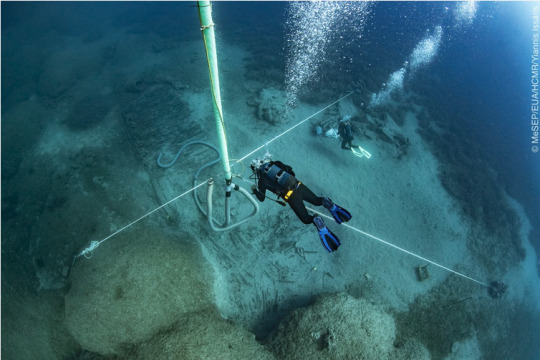
The wreck at a depth of 23m (x)
The ship, owned by the Earl Elgin (Tomas Bruce, 7th Earl of Elgin & 11th Earl of Kincardine), had sailed from the port of Piraeus two days earlier, having circumnavigated the eastern Mediterranean under the command of Captain William H. Eglen, with the intention of bringing antiquities to England. These had previously been removed by Lord Elgin's team from various monuments of the Acropolis and Athens, including the Parthenon, and loaded onto the ship in 17 crates.
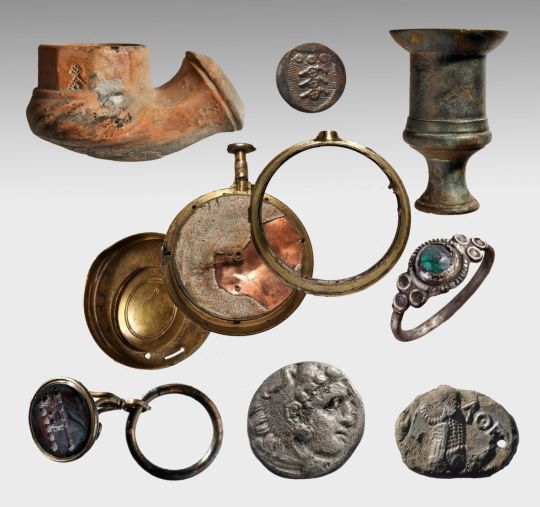
Small finds from the wreck (x)
At the time of the accident there were 12 people on board and this crew consisted of Captain William H. Eglen, accountant or freeman John Macpharlan (or Macfarlan), navigator Manolis Constantine Malis and three sailors: John Wigton, Ross (surname only known) and a third whose name is not preserved and who was supposedly from Gibraltar. Accompanying Lord Elgin as passengers were his secretary William Richard Hamilton, the topographer and archaeologist Captain William Leake, the captain of artillery Lieutenant John Squire, and three other men listed as servants of the above passengers, and of course the cargo on board.
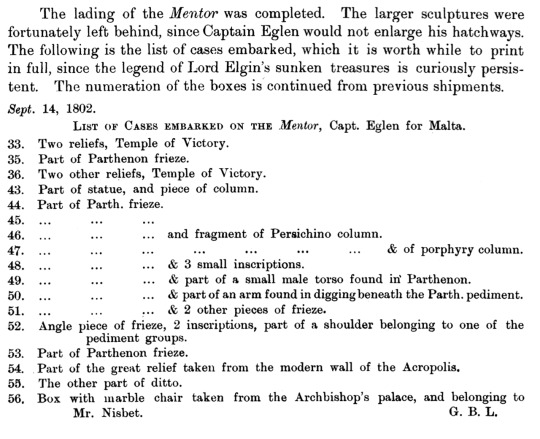
List of Elgin Marbles on the Mentor brig, in : Lord Elgin and His Collection, by Smith, A. H. The Journal of Hellenic Studies, vol. 36, 1916, pp. 163–372 (x)
When Lord Elgin was informed of the incident, he instructed his secretary to remain on Kythera until the ancient cargo was recovered. A team of sponge divers, who were active in the area at the time, was hired for the salvage. For this purpose, a large part of the ship had to be destroyed to allow access to the interior. In the course of the operation, much of the ship's equipment (auxiliary boats, sails, ropes, cannons, personal effects, etc.) was also recovered.
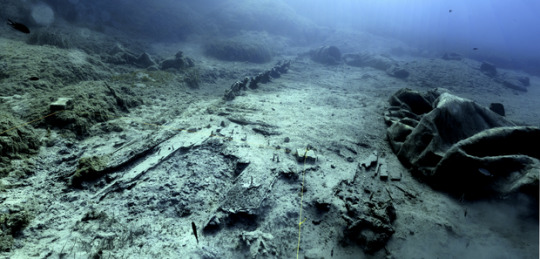
The wreck (x)
But it was not until three years later on 16 February 1805 that the last missing boxes were brought to England by order of Admiral Nelson with the British-flagged Lady Shaw Stewart, commanded by Captain George Parry, and the schooner Reynard.
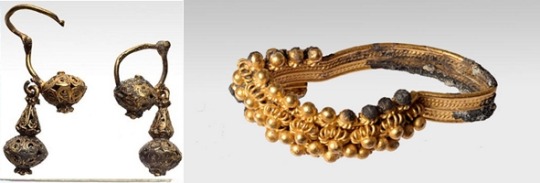
A pair of earrings and a gold ring (x)
Modern excavation campaigns in 2013, 2015 and 2019 provided new insights and even revealed new finds that were not recovered at the time. Besides gold jewellery, ancient coins, Rhodian amphora stamps, fossils, a part of an Egyptian pharaoh statue and a fragmented Egyptian marble inscription were found.
53 notes
·
View notes
Text
The world of the Cambrian Period was a strange combination of both familiar and alien. The land would have seemed rather barren, populated mainly by microbes and algae, yet the oceans teemed with creatures already identifiable as sponges, comb jellies, jellyfish, acorn worms, vertebrates, echinoderms, arrow worms, annelids, molluscs, and brachiopods – small and primitive-looking in some cases but still recognizable enough.
But at the same time there were "weird wonders" everywhere, things much harder to identify, with shapes so bizarre that their initial discovery was met with laughter.
Animal life was exploring so many different possibilities for body plans and ecologies, and one lineage in particular dominated this explosion of evolutionary experimentation: the arthropods.
Arthropods are represented today by the chelicerates (sea spiders, horseshoe crabs, and arachnids), myriapods (millipedes and centipedes), crustaceans, and insects, and together these groups make up over 80% of all known living animal species and are vital parts of almost every ecosystem on the planet.
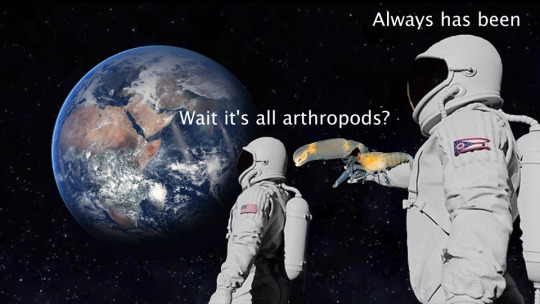
We live on Bugworld, and this month we're going to see where that all began. Welcome back to the Cambrian Explosion series (only a couple of months later than usual) and the Earth of over half a billion years ago: the time of the Rise Of The Arthropods.
———
Cambrian Explosion #32: More Ediacarans & Ecdysozoan Origins
Arthropods are part of a major branch of animal life known as ecdysozoans – characterized by growing via molting their outer covering. They're estimated to have last shared a common ancestor with their cousins the spiralians around 600 million years ago, and the protostome ancestors of both these groups split from the deuterostomes even earlier than that.
So ecdysozoans must have originated somewhere in the Ediacaran Period, but so far none of the enigmatic fossils from that time period have been definitively linked to this group.
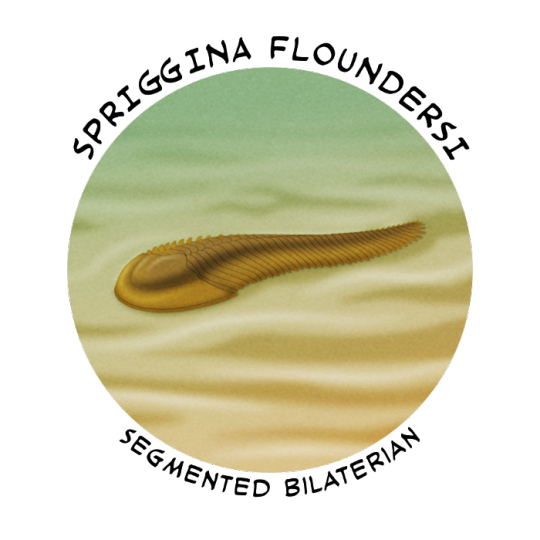
Spriggina floundersi certainly looks like it could have been some sort of early arthropod, with a defined "head" and a segmented body covered in plates that made it resemble a trilobite – although its segments appear to be glide reflected rather than symmetrical. Up to 5cm long (2"), its known from the South Australian Ediacara Hills fossil site and dates to about 555 million years ago.
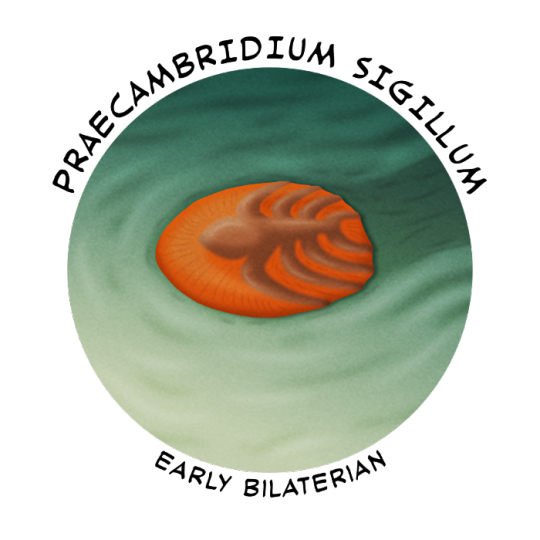
Praecambridium sigillum lived in the same time and place as Spriggina, but was much smaller at just 4mm long (0.15"). Its vaguely trilobite-like body had at least 5 segments, and this has also led to it being proposed as a potential arthropod-like animal.
Despite their superficial similarities, however, currently neither of these species are thought to be particularly closely related to ecdysozoans, with their trilobite-like shapes instead being the result of convergent evolution. Instead they may be part of a separate proposed phylum known as Proarticulata, a very early branch of bilaterian animals whose closest living relatives might be the weird little xenacoelamorphs.
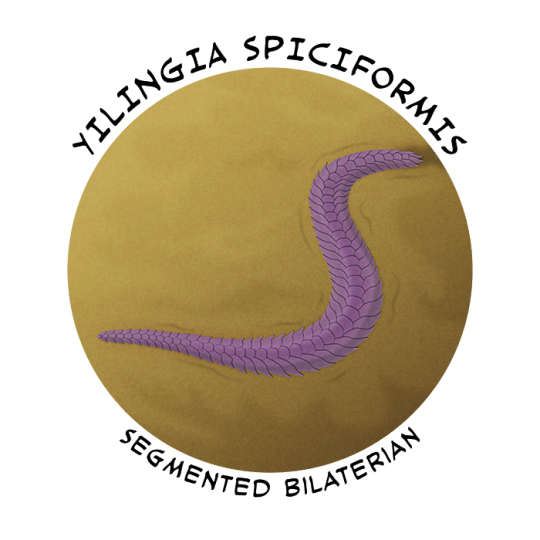
The most likely Ediacaran arthropod-relative discovered so far is actually the segmented worm-like Yilingia spiciformis, which was originally featured back in part 1 of this series – and even then it could instead be closer related to annelids, or be another example of convergence, and so it can't be confidently classified as anything more specific than "an early bilaterian".
Isolated microfossil spines from the late Ediacaran may also be from early ecdysozoans, possibly originating from a scalidophoran-like animal.
———
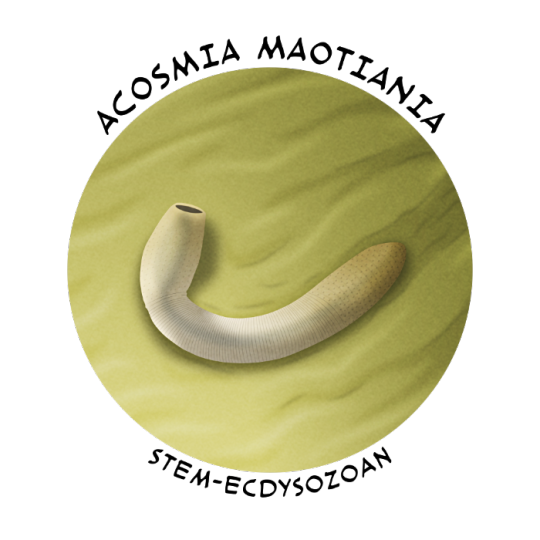
But outside of the weird Ediacarans, the closest thing we currently have to an example of what the ancestral ecdysozoans might have actually looked like is Acosmia maotiania.
Originally described as a priapulid worm, this species was recently reassessed as a "stem-ecdysozoan" – basically part of an ancient branch of the ecdysozoans that arose after the split from the spiralians but before the common ancestor of all other known forms existed, making it a evolutionary "cousin" to the entire rest of the group.
It's known from the Chinese Chengjiang fossil deposits (~518 million years ago) and measured up to about 10cm long (4"). It had a two-part worm-like body plan, with its mouth located at the tip of a bulbous proboscis region at the front, and a ringed trunk region further back.
However, it lacked the characteristic radial teeth and throat structures seen in other early ecdysozoans like scalidophoran and lobopodians. This suggests the common ancestor of the rest of the group may have been an Acosmia-like wormy animal with a combination of a ringed body and scalidophoran-like mouth structures – and maybe eventually some other Cambrian fossils currently classified as priapulid-relatives may turn out to also be stem-ecdysozoans instead.
———
Nix Illustration | Tumblr | Twitter | Patreon
#science illustration#paleontology#paleoart#palaeoblr#cambrian explosion 2021#rise of the arthropods#ediacaran#spriggina#praecambridium#proarticulata#yilingia#bilateria#eumetazoa#animalia#acosmia#ecdysozoa#protostome#art#oh worm#long post#buckle up we're getting this DONE this month#...probably. hopefully.#I calculated the odds of this succeeding versus the odds I was doing something incredibly stupid... and I went ahead anyway
301 notes
·
View notes
Text
Zack: If we had enough sponges, we could soak up all the water in the ocean and explore the caverns below. Perhaps we'll find fossils of ancient creatures or live ones we thought to be extinct. Maybe even an underground world-
Tigress: What led you to this? And who the fuck are you??
#carmen sandiego#incorrect carmen sandiego#incorrect quotes#carmensandaleggos#carmen sandeigo#tigress#sheena#zack
114 notes
·
View notes
Link
A mermaid.
A merman.
A shark with 2 heads and tentacles where its tail should be.
The net has been chewed through.
A skeleton with different gold bones.
A school of singing fish.
The tentacle of a kraken.
A bunch of crabs with weirdly shaped claws. Some look like they have hands, paws, knives, trident, etc.
A kraken toddler.
The kid of a mermaid & merman. Around 6 or 7 years old.
A 20ft. white lobster.
A severed ear with an attached golden earring.
A message in a bottle.
Dragon-turtle egg.
A poisonous fish that deals 1D8 damage when eaten.
A school of quippers.
A locked chest.
Fragments of a wrecked vessel.
Eggs of a Sahuagin.
A coral/barnacle-encrusted magical weapon/armor.
A concrete block with the remnants of two humaniod legs sticking out. If the players break the concrete, a ring of waterbreathing can be found on one of the toes. Kinda makes you wonder how the person died if it wasn’t by drowning….
A ships intricately detailed figurehead.
A chum bucket.
A pineapple with a sea snail crawling all over it.
A lobster trap containing a crab, a squid, a sea sponge, and a starfish.
A glass ball containing a live squirrel.
A broken leg bone.
A letter in a bottle. Written on the letter is a recipe for a very delicious sandwich.
A painting of a pirate and his parrot.
A bloated corpse that looks exactly like you.
The net is empty, but coated with gritty, pitch-black oil.
A perfectly intact but not fossilized dead animal that has been extinct for millennia.
A fist-sized, segmented black metal pyramid that causes everyone around it to vie for possession of it with increasing violence unless it is submerged in salt water.
A skull of the fishman species with noticeable gouges and cuts around the eye sockets.
Driftwood.
The most beautiful piece of driftwood you’ve ever seen.
A rune-covered iron flask sealed with a silver band.
A wooden doll without clothes.
A grapefruit sized stone sphere that mysteriously floats in salt water.
A key carved from bone.
A fine/expensive looking cloak that hasn’t begun to rot yet.
A large cod. (Gold ring in its stomach)
A scroll case with a now-indecipherable treasure map.
Your net is torn from your hands: a DC 25 perception check from on the ship, or a DC15 from in the water, reveals an immovable rod that it got caught on.
A sentient jeweled necklace which appears to be worth several thousand gp but tries to convince the wearer to kill themselves.
An ornate wooden statue of some god or goddess, now covered in barnacles.
A bottle containing one copper piece and a note reading “spend it well”. The coin is too big to leave the bottle.
A sleeping human girl wearing barnacle/seaweed covered clothes that look incredibly old. Once she is relatively dry, she wakes up.
A strange stone tablet with a map etched on it, and writing in Aquan.
A live crab, but made of solid gold and encrusted with gems.
The anchor of a legendary pirate vessel.
A talking fish that offers to grant a wish in exchage for being set free.
A rusty sword that seems to glow, but only when you look at it from the corner of your eye.
A carved stone talisman on a broken cord, tangled in seaweed.
A bottle of rum.
An ancient bottle of wine, encrusted with barnacles.
A brass oil lamp – maybe you should try rubbing it clean…
1d8 spiky green fruits. It will cause you to vomit sea water (and just sea water) if you eat it.
A golden compass and astrolabe.
A sea-elf offering slightly damp sea scrolls for sale. Very handy during storms.
Giant 30ft. clam. 50% chance for a pearl.
Giant lobster being ridden by a sea goblin.
A talking sea turtle.
A reverse mermaid. (Top half fish and human legs).
A bottle with a (d100)potion inside.
A school of fish that cause hallucinations when consumed.
A giant 25ft oyster. Cracking it open reveals a Sea Dragon egg instead of a pearl.
A chunk of meteorite that fell into the ocean.
A glass helmet that grants darkvision and waterbreathing.
A trident.
A shipwrecked sailor.
The leftovers from a sauhaugin attack.
Large orbs that appear to be made of pure water, which are slightly gesticulating (an aquatic variant of gelatinous ooze).
A baby in a basket (race can very based on DM descretion).
A pirates peg leg. Made of two parts, a wide brim that attaches to the leg and the actual peg. Unscrewing it reveals the leg is hollow, with a map on the inside.
A Demigod who had one too many to drink. Return him to their dad to get a reward.
A shackled live Triton.
Several large pieces of perfectly polished sea glass.
An old boot mimic.
A bag of coins from different civilizations, not all of them are from recent civilizations, but all of them are covered in a black, viscous ooze.
A clam that’s sealed shut, with an unbreakable shell. If the shell is pried open, the clan starts signing sea shanties in the wrong key – very, very loudly.
A bottle with a map in it.
An entire campfire, still lit, that doesn’t burn anything.
A small red crab that speaks fluent Common with a melodic accent. Once in the boat it demands to be placed back under the sea.
A barnacle clad silver hand mirror, miraculously still intact. When you try to look at your reflection, you see yourself as a bloated dead corpse.
A sealed container with an important letter inside.
An odd & very fancy looking coffin that is sealed.
A sextant made of coral, covered in kelp.
A harpoon.
Gold coins that are (20d10 x 100) years old.
A whale screaming bloody murder.
The eggs of a kraken.
A very large squid. Could easily be mistaken for a kraken.
The skulls of Giants. 8 to be precise.
The Kraken
A shark with half-formed legs.
A shell inscribed with runes (a mermaid’s love poem).
A giant that was out for a swim. He got tangled in the net.
An octopus with a knife and a salty look in her eye.
A mysterious egg that doesn’t belong to any known species.
#d20#rpg#dnd#dungeons and dragons#fantasy#sword and sorcery#campaigns#fairy tale#mythology#fable#dungeon master#dm#game master#gm#hackmaster#magic item#magic weapon#magic ring#spell book#d12#d10#d8#d6#d4#d100#dice
21 notes
·
View notes